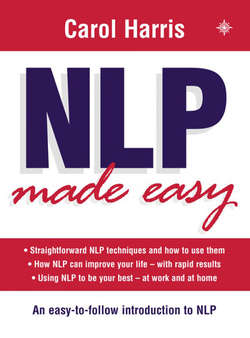Читать книгу NLP Made Easy - Carol Harris - Страница 42
Associations
ОглавлениеWhere did NLP come from? Many of the ideas used in NLP originated in much earlier times. Certainly many of the concepts were known about decades ago and some were mentioned, although in very different terminology, centuries ago. There are, however, a number of specific connections between NLP and other established disciplines, in particular the following:
Applied psychology: It is easy to think of NLP as a branch of applied psychology. To label it in this way is really to diminish its impact, as it goes beyond the bounds of traditional psychology, but it is probably a good initial way of considering it. One explanation of how NLP goes beyond conventional psychology is as follows: ‘While traditional clinical psychology is primarily concerned with describing difficulties, categorizing them, and searching for historical causes, NLP is interested in how our thoughts, actions, and feelings work together right now to produce our experience.’ (Faulkner) There is also a link with psychometric testing (and some Jungian ‘traits’) in the use of one of the NLP language patterns called Meta-Programmes (see Chapter 5).
Gestalt psychology/psychotherapy: One of the early role models for NLP was Fritz Perls, the reputed father of Gestalt psychotherapy. Gestalt relates to the linkages between elements, so that an entity can be understood through the interrelationships of its parts; the parts alone do not necessarily make sense. (One area of NLP deals with ‘parts’ and that will be covered in more detail in Chapter 3.)
Ericksonian hypnosis: Another early role model was Milton Erickson and his influence on NLP has been enormous. Unlike classical hypnosis, the Ericksonian approach is seemingly low key and unobtrusive. Much use is made of indirect language, suggestion and utilization of the patient/client/subject’s own patterns of speaking, breathing and moving in order to bring about change. Erickson himself was expert at adapting his approach to the specific needs of the individual with whom he was working and this way of working has informed many of NLP’s later practitioners (although the indirect approach is closely linked with Erickson, he was substantially influenced by classical hypnosis and did use a lot of direct techniques himself).
Systems thinking/cybernetics: Much of NLP utilizes systems thinking. Work by Ashby, Beer and others has had a major impact on how NLP has developed and been used and many of the NLP models presented in Chapter 3 explore the systemic nature of different areas of experience.
Linguistics: Much of NLP originated in the work of linguists, including Korzybski and Chomsky. Such people had laid down many of the principles which underlie NLP’s language patterns. Some of the connections which have been made are with the ways in which language represents experience, especially in a metaphorical sense, and the ways in which language demonstrates people’s underlying motivational and Behavioural patterns.
In addition, some topics that are becoming associated with NLP are:
Accelerated learning: Accelerated learning puts much emphasis on the needs of the individual and the helpfulness of recognizing and utilizing individual patterns in order to enhance learning and development. The earliest writer on this topic was the Bulgarian Georgi Lozanov, working in the 1960s, and other famous names in the field are Ostrander, Schroeder and Jenson, who have written at length about how to improve trainer/trainee relationships. In particular, accelerated learning puts the onus on the trainer to ensure that the learner is in a resourceful state in which to learn, and this means that learning is not simply a one-way process of pushing information towards a recipient and hoping it will stick, but involves creating an atmosphere and an environment in which interaction and mutual respect can lead to individual growth.
Bodywork: NLP is increasingly being associated with the field of physical development as well as psychological enhancement. Some examples of current links are the Alexander Technique, Feldenkrais, kinesiology, tai chi, voicework/singing, and so forth. With all of these techniques, practitioners use a mixture of body movement and mental/emotional control to achieve results.
NLP constantly draws upon other disciplines and approaches to integrate appropriate parts of them with its own ways of working. Because of this, NLP is evolving all the time and, while it remains recognizable, is fluid and flexible.
